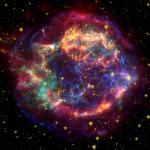
Date: Saturday, October 26, 2019 - 10:30
Venue: Martin Wood Lecture Theatre, Clarendon Laboratory
Stars sometimes explode with such violence that for a week or two they outshine an entire galaxy of 100 billion stars. These `supernova explosions' can end the lives of both massive, young stars and welter-weight dead stars: white dwarfs. They involve diverse physics - the only common factor is the dominant role played by relativity - that is played out on a bewilderingly large range of scales. They have been detected through neutrinos in addition to electromagnetic radiation, and the gravitational waves they emit may soon be detected. Observations of distant supernovae suggest that the expansion rate of the universe is accelerating.
In the first talk, James Binney will outline the physics that leads to prodigeous release of energy in core-collapse and deflagration supernovae.
In the second talk, Philipp Podsiadlowski will explain how this energy (sometimes) creates a visible fireball, the physics of which gives rise to the observational signatures of different types of supernovae, before going on to explain the role of supernovae in the production of the heaviest elements in the periodic table.
In the final talk Subir Sarkar will explain how deflagration supernovae have been used to infer that the Hubble expansion rate is accelerating, and critically assess whether the acceleration is real and due to `dark energy’.
Speakers

Prof James Binney
What makes stars go bang?
Podcast Presentation (PDF)

Prof Philipp Podsiadlowski
Supernova Explosions and their Role in the Universe
Podcast Presentation (PDF)

Prof Subir Sarkar
Cosmic acceleration revealed by Type la supernovae?
Podcast Presentation (PDF)
Type Ia supernovae turn out to be ’standard(isable) candles’ so by observing them out to cosmological distances, any change of the Hubble parameter with time can be determined. Such observations have been interpreted to mean that the expansion rate of the universe is accelerating as if driven by Einstein’s Cosmological Constant. I will discuss the analysis of the data and show that the inferred cosmic acceleration may in fact be an artefact of our being non-Copernican observers, rather than evidence for a dominant component of 'dark energy' in the Universe.